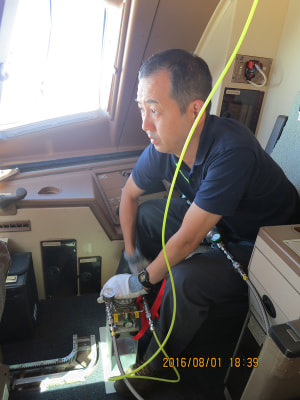With the close cooperation of JAPAN AIRLINES, our group has been conducting atmospheric observations of greenhouse gases in the upper air at the northern high latitudes, using passenger aircraft. I would like to introduce our air sampling performed in the aircraft flying between Japan and Europe.
On the morning of August 1, before boarding of other passengers, I met up with JAPAN AIRLINES’ flight crew and boarded their flight 045 to Paris leaving Haneda at 10:50. I have a special permission of being inside the cockpit, where the air conditioning vent lets out the air, which is free from being contaminated with CO2-rich cabin air. From this vent, we can sample air. I brought some equipment for sampling on board, such as a manual pump, pipes, and 12 cylindrical flasks to store air samples. After the aircraft reached the cruising altitude, I started setting of the equipment (Photo 1). I rotated the handle of the pump at each 12 fixed longitude between 10°E and 135°E to fill the flask with the air. As human is one of a source of CO2, I have to take care not to mix the air in the cockpit with the sampled air while rotating the handle of the pump many times until the air in the flask and pipes is sufficiently replaced by the sample air (Photo 2). At around 125°E, I felt some turbulence and the seatbelt sign was turned on. I was not able to continue the sampling work all that while. It was my first experience out of the previous seven flights. I heard from a flight crew that cumulonimbus clouds have recently been well-developed even at high latitudes than before.
While the sampling work was not carried out, I watched outside from the aircraft window (Photo 3), not being bored during the 12 hour long flight. I was watching the appearance of Earth's surface and changes in the clouds. They were very interesting because clouds look different from those we see from the ground. I have often heard about CO2 absorption by the terrestrial biosphere increases at northern high latitudes during summer, and I was able to imagine the phenomenon more clearly with the bird’s eye view of the majestic continent underneath. I felt that aircraft is an effective platform for observing the Earth's environment ever before.
Around one hour before arrival, finished packing up the observation equipment, I gazed out from the window and found rural landscapes drawing geometric patterns composed of post-harvest yellows and pre-harvest greens. It was a moment of feeling a sense of relief because the work comes to the end. I, however, was not truly relieved until I see the analysis results of the sampled air after I come back to Japan.
Not even going through the French immigration, I flew back to Japan with the same aircraft. I arrived home next day and my overnight foreign trip was finally over.
As always, the observation was smoothly performed. I would like to acknowledge the quality support of all JAPAN AIRLINES staff.
Kazuhiro Tsuboi (Meteorological Research Institute)
 Photo 1: Manual sampling equipment (Pump and Flask)
Photo 1: Manual sampling equipment (Pump and Flask)
 Photo 2: Situation of air sampling
Photo 2: Situation of air sampling
 Photo 3: Landscape from the window
Photo 3: Landscape from the window
*These pictures have taken in helping to ensure the safety with the special permission of JAPAN AIRLINES.




